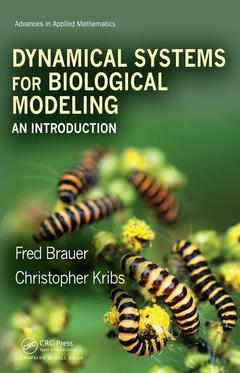Description
Dynamical Systems for Biological Modeling
An Introduction
Advances in Applied Mathematics Series
Authors: Brauer Fred, Kribs Christopher
Language: English
Subject for Dynamical Systems for Biological Modeling:
Keywords
Asymptotic Stability; Endemic Equilibrium; Biological Modeling; Ordinary Differential Equations; Continuous Dynamical Systems; Beverton Holt Model; Modeling Systems Of Populations; Boundary Layer System; Discrete Dynamical Systems; Computer Algebra System; Nonlinear Differential Equations; Fitzhugh Nagumo System; Systems With Sustained Oscillations And Singularities; Extinction Equilibrium; Bifurcation Diagram; Phase Portrait; Logistic Equation; Modified Euler Method; Logistic Difference Equation; Saddle Node Bifurcation; Difference Equations; Positive Equilibrium; Linearization Theorem; Fitzhugh Nagumo; Carrying Capacity; Locally Asymptotically Stable; Linear System; Globally Asymptotically Stable; Van Der Pol Equation; Fitzhugh Nagumo Model; Singular Perturbation
120.12 €
In Print (Delivery period: 15 days).
Add to cart478 p. · 15.6x23.4 cm · Hardback
Description
/li>Contents
/li>Readership
/li>Biography
/li>
Dynamical Systems for Biological Modeling: An Introduction prepares both biology and mathematics students with the understanding and techniques necessary to undertake basic modeling of biological systems. It achieves this through the development and analysis of dynamical systems.
The approach emphasizes qualitative ideas rather than explicit computations. Some technical details are necessary, but a qualitative approach emphasizing ideas is essential for understanding. The modeling approach helps students focus on essentials rather than extensive mathematical details, which is helpful for students whose primary interests are in sciences other than mathematics need or want.
The book discusses a variety of biological modeling topics, including population biology, epidemiology, immunology, intraspecies competition, harvesting, predator-prey systems, structured populations, and more.
The authors also include examples of problems with solutions and some exercises which follow the examples quite closely. In addition, problems are included which go beyond the examples, both in mathematical analysis and in the development of mathematical models for biological problems, in order to encourage deeper understanding and an eagerness to use mathematics in learning about biology.
ELEMENTARY TOPICS. Introduction to Biological Modeling.Difference Equations (Discrete Dynamical Systems).First-Order Differential Equations (Continuous Dynamical Systems).Nonlinear Differential Equations. MORE ADVANCED TOPICS. Systems of Differential Equations.Topics in Modeling Systems of Populations.Systems with Sustained Oscillations and Singularities. APPENDICES. An Introduction to the Use of MapleTM. Taylor’s Theorem and Linearization. Location of Roots of Polynomial Equations. Stability of Equilibrium of Difference Equations. Answers to Selected Exercises.Bibliography.
Fred Brauer, PhD, University of British Columbia, Vancouver, Canada
Christopher Kribs, PhD, University of Texas at Arlington, USA




